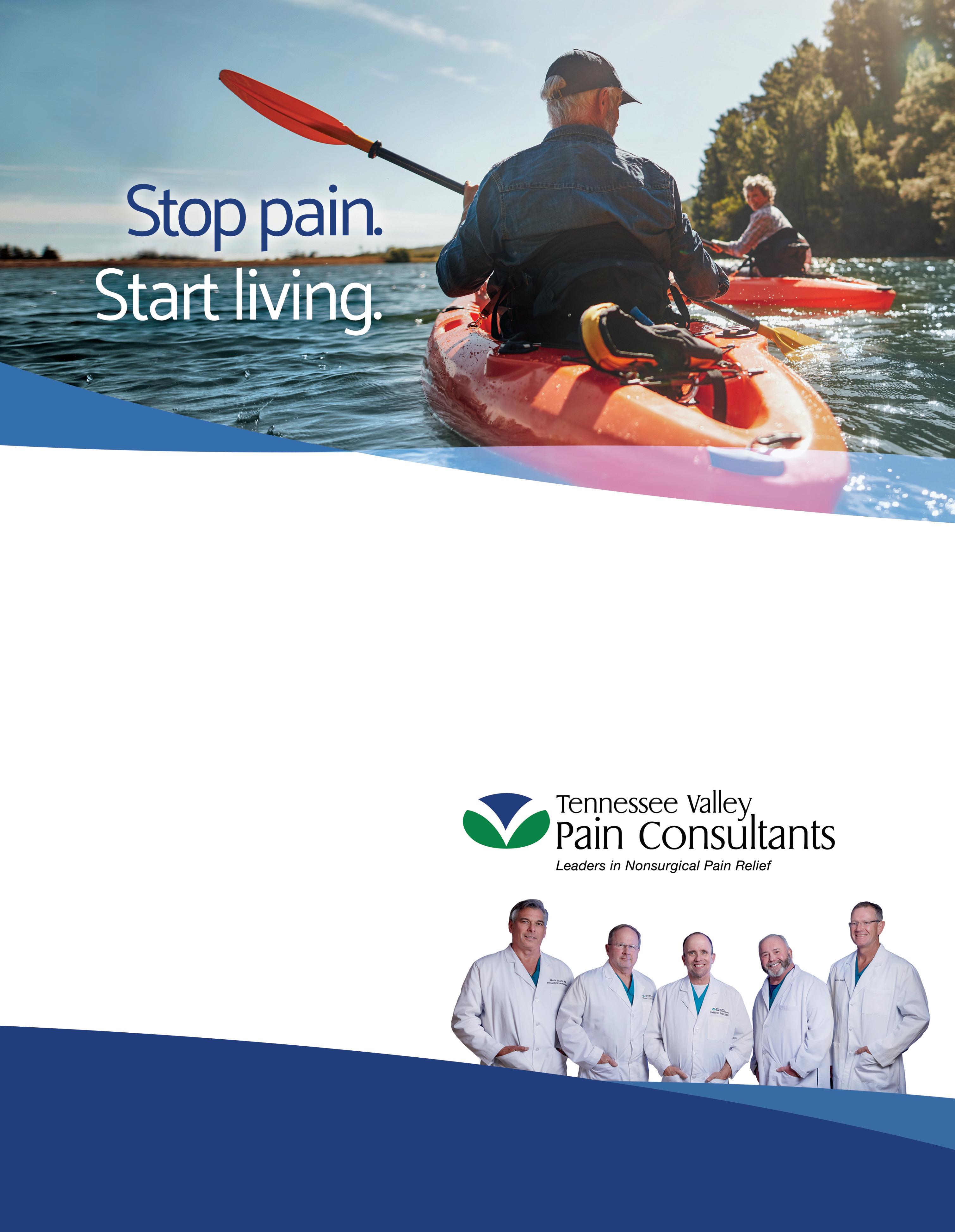



Visit hh.careers to launch your search for a more rewarding future. Whatever your expertise, opportunity awaits at Huntsville Hospital Health System.






Inside Medicine | Winter Issue 2023 5
WellStone
CONTRIBUTORS
Kimberly Waldrop, MA
Justin Daigre, MD
Victor Chin, MD
Karen Petersen
Joi Rice
Rachel Sullivan, LMFT
William Budd, PhD
Adam Reiger
Sarah Sharman, PhD
Libby Shadinger, MD
Tiernan O'Neill
Carl Stephenson, MD ADVERTISING
Terrie Ledbetter, Senior VP
GRAPHIC
Leigha Parker
Blake Bentley, President
Kelly Reese, Founder
Key Common,
6 Inside Medicine | Winter Issue 2023
Health History FEATURES CONTENT CONTENTS
Family
& MARKETING
DESIGNER
CHIEF EDITORIAL WRITER
Kimberly Waldrop, MA PUBLISHERS
COO
Inside Medicine | Winter Issue 2023 features & Bunion Surgery Sharing with Purpose
MD how it has changed
www.insidemedicinemagazine.com
The information and opinions contained in this publication constitute general medical information only and should not be construed as medical advice. Before making important medical decisions, readers should consult with a physician or trained medical provider of their choice and have their needs and concerns assessed in a clinical setting appropriate for their problem.
So Many Questions what does it mean Making a Difference VOL 3 ISSUE 22 Suicide Prevention
Why Your Doctor Asks
supports Alabama's need obtaining care locally
our mission to establish
an
14 30 08 16 Breast Cancer 36 Above All, Don't Fall fall prevention and therapy 44
Join
and grow
alliance among our community and healthcare providers. Together, we can change the way healthcare information has been and will be distributed for years to come. To reach our readers, whether through editorial contribution or advertising, please contact Kelly Reese at 256.652.8089 or kellyreese.im@gmail.com
} HEALTH FEATURE
Inside Medicine | Winter Issue 2023 9
10 Inside Medicine | Winter Issue 2023



































} COVER FEATURE









} COVER FEATURE } COVER FEATURE



18 Inside Medicine | Winter Issue 2023
} TESTIMONIAL
MENTAL HEALTH HE WORKPLACE in
MENTAL HEALTH THE WORKPLACE in
 by: Rachel Sullivan, LMFT
by: Rachel Sullivan, LMFT
Mental health in the workplace has become an increasingly popular topic as of late.
As adults we spend a large portion of our lives at our place of employment, so it stands to reason that these places should be somewhere that add value to our lives rather than decrease it A recently released workforce survey includes statistics that employees are increasingly emphasizing the importance of workplaces that prioritize mental health. Based on the number of hours that people spend at work, this makes a lot of sense and is something that company owners and management would do well to pay attention to. If you are in one of these positions here are three things that you can do to begin increasing wellness in the workplace.
As adults we spend a large portion of our lives at our place of employment, so it stands to reason that these places should be somewhere that add value to our lives rather than decrease it. A recently released workforce survey includes statistics that employees are increasingly emphasizing the importance of workplaces that prioritize mental health
Based on the number of hours that people spend at work, this makes a lot of sense and is something that company owners and management would do well to pay attention to. If you are in one of
th iti h th thi th t
Mental health in the workplace has become an increasingly popular topic as of late.
Understand exactly what mental health is Often carrying a negative connotation, mental health literally means the health of our mental state This exists across the spectrum and is not inherently a negative term Everybody has mental health existing from illness to wellness and many factors in our everyday life, including our workforce environment, contribute to where we are on that spectrum As a result, employers can increase employee mental wellness by ensuring that the jobsite has a firm understanding of what mental health is and what it encompasses
Create an environment of openness around mental health Research indicates that workplaces that support a positive, ongoing, conversation around mental health have employees who are more productive, feel more secure in the workplace, and therefore positively contribute to the company's overall mission For company owners and employers this equates to a stronger bottom line due to lower employee turnover While this step may seem daunting for employers there are resources available to help begin facilitating this conversation
Be purposeful about proactive mental wellness training. This piece is crucial because mental health conversations are not going anywhere I believe employers will continue to lose valuable employees if they are not prioritizing training around mental wellness in the workplace While doing so may seem overwhelming, fear of this topic should not be an excuse to avoid integrating this important piece into ongoing training in the workplace

If you are interested in what developing a strong mental health conversation can look like, or have questions around how to get started, I encourage you to reach out You can find out more information here
Stay well friends.
Rachel Sullivan, LMFT, CFLE-P Solid Ground Counseling Center
Inside Medicine | Winter Issue 2023 21
U N D E R S T A N D E X A C T L Y W H A T M E N T A L H E A L T H I S . C R E A T E A N E N V I R O N M E N T O F O P E N N E S S A R O U N D M E N T A L H E A L T H B E P U R P O S E F U L A B O U T P R O A C T I V E M E N T A L W E L L N E S S T R A I N I N G
New Yearbetter you!
by: William Budd, PhD
With the dawn of a new year, many of us will make a resolution to improve our health. Three of the most common resolutions involve health improvement.
22 Inside Medicine | Winter Issue 2023
Unfortunately, the odds of keeping a resolution are not in our favor. Only 8% of people will keep their resolution for the entire year. Since many of us are looking to improve our health, it is important to discuss our resolutions with our healthcare provider. An important component to our health maintenance and improvement is the annual examination with laboratory testing. This visit sets our baseline and helps identify common physical issues prior to them manifesting themselves to us.
One of the most important laboratory tests is the Glycated Hemoglobin (HgB-A1C). This test measures the average of blood glucose over the previous 2-3 months. This laboratory test is one of the tests used to diagnose diabetes mellitus. 15% of the US population currently suffers from diabetes mellitus, sometimes referred to as sugar diabetes.
Diabetes mellitus is the result of our body’s inability to maintain a healthy blood glucose level. There are two classifications of the disease. Type I diabetes occurs when the pancreas is unable to manufacture insulin, a hormone required for our body to use glucose. Persons with this form of the disease need to inject insulin and closely monitor their intake of carbohydrates. Type II diabetes is the result of prolonged periods of elevated blood glucose levels that result from inadequate production of insulin from the pancreas or the body’s resistance to the insulin produced. Treatment of the disease varies with diabetes and severity of the condition.
Symptoms of diabetes mellitus are often subtle and can go unrecognized for prolonged periods. The most common symptoms are frequent urination, excessive thirst, hunger, and fatigue. Excessive levels of blood glucose led to long-term consequences. Complications include heart disease, stroke, nerve damage and eye damage. Once diagnosed with diabetes or pre-diabetes, it is important to maintain healthy blood glucose levels to minimize the longterm effects of the disease.
Inside Medicine | Winter Issue 2023 23


24 Inside Medicine | Winter Issue 2023
Diet and exercise are often used to halt the disease's progression from pre-diabetes to diabetes. Diet and exercise are important components of a healthy lifestyle for any diabetic patient. Most people with elevated blood glucose levels find it difficult to begin an exercise program. It is important to discuss an exercise program with your healthcare provider prior to beginning to minimize your chances of an adverse outcome. All exercise programs should start slowly and gradually increase in duration and intensity.
Metformin is often used as a first line agent in the treatment of Type II diabetes. This medication increases the sensitivity to insulin at the cellular level causing our body to utilize carbohydrates causing the level of glucose more efficiently in the blood to decrease. This medication also suppresses a person's appetite. Metformin and other related medications have been on the market for nearly 30 years. Metformin commonly causes gastrointestinal disturbances such as nausea, vomiting and diarrhea. In the initial stages of the disease, Metformin can be a successful adjunct to diet and exercise.
Glucagon-like peptide 1 (GLP1) receptor agonists are a new class of medications that have demonstrated strong results in management of Type II diabetes. These medications such as Ozempic, Mounjaro, and Wegovy when used with diet and exercise produce dramatic responses in blood glucose management and weight loss. Semaglutide (Ozempic and Wegovy) was approved by the FDA in 2019. These medications increase insulin production from the pancreas and inhibit production of glucagon. This effect improves the utilization of glucose thereby reducing overall blood glucose levels. These medicines are administered by injection into fatty tissue once per week. Side effects include delayed gastric emptying and reduced intestinal mobility leading to nausea and constipation. Person’s that take Ozempic or Wegovy as directed typically lose weight. The average person using these medications as directed will lose up to 15% of their body weight.
In 2022, Mounjaro (Tirzepatide) was approved by the FDA for treatment of Type II diabetes mellitus. This medication combines GLP-1 stimulation with a synthetic hormone gastric inhibitory polypeptide (GIP). Combining these two hormones further reduces gastric
emptying, causing persons to feel fuller for longer periods of time, reducing overall food consumption. In clinical trials, participants lost up to 22% of their body mass with 91% of participants reducing their A1C levels to less than 7.0 and 47% of patients reduced their A1C to non-diabetic levels. In addition to glycemic control and weight loss, Mounjaro has been shown to reduce cholesterol and triglycerides. These classes of medications have received a lot of attention over the past few months as weight loss medications. Semaglutide (Wegovy) is approved by the FDA for persons with a body mass index greater than 30% or 27% with a health complication. Tirzepatide (Mounjaro) is not currently approved for weight loss, but the manufacturer is completing the requisite clinical trials and plans to apply for approval in 2023.
Uncontrolled blood glucose levels lead to various complications including heart disease, stroke, kidney damage, eye damage, and nerve damage. It is important to monitor blood glucose levels routinely and check your A1C level at least once per year. The variety of medications to treat diabetes has improved over the past 10 years leading to improved long-term outcomes for patients with the disease.
from page 23
...cont’d
real estate

Timing your next transaction
 by: Adam Reiger
by: Adam Reiger



26 Inside Medicine | Winter Issue 2023
Every commercial real estate transaction has an ideal timeframe to begin the process. Most healthcare professionals understand that opening a new office or relocating an office doesn’t happen overnight, but the majority of professionals are not aware of the ideal timeframes for each type of transaction. Different types of problems arise when starting a transaction too early or too late, and both need to be avoided.
too early
If you start the process too early, it creates a scenario where you spend your valuable time looking at properties and evaluating options, working with lenders and other members of your team, only to find out the landlords or sellers won’t negotiate with you yet. Many landlords and sellers won’t take their spaces off the market for extended periods of time while waiting for the tenant or buyer to be ready to transact, because there is too much time before the transaction will actually take place.
Or if they do negotiate, they won’t be willing to offer you even close to their best terms since they are going to lose income on holding a space vacant for an extended period of time. On the other hand, if they will put forth reasonable terms, it is predicated upon you moving forward immediately, which can leave you stuck paying for a space you can’t occupy for a period of time or paying unnecessary rent on your former space if you leave early.

When starting a transaction too late, an entirely new set of problems arise. To start, most people underestimate how long a commercial lease or purchase transaction takes. They imagine it is similar to buying a home or leasing an apartment, which unfortunately is not the same as a commercial transaction timeline. Simply identifying the top options and then negotiating a mutually agreeable deal can take several months. The legal process of reviewing contracts and finalizing details with lenders, architects, contractors, and equipment and technology providers comes next; this portion can also take months.
This is followed by the build out process if renovations are required. While you can build out a new space in 6 to 10 weeks depending on the size and scope of the project, you first have to design the space, then get construction documents and engineered plans created, then submit for and receive permits to start the build out. After construction, you need to leave time for installing furniture, fixtures, equipment and technology, final permitting and approvals, while also leaving room for uncontrollable delays, and change orders.
If you are relocating from a previous office and you don’t vacate your former space prior to the lease expiring, you’ll likely pay between 125 to 200% of your last month’s rent based on a provision found in most leases called “Holdover.” This allows the landlord to charge you a higher month-to-month lease rate as a penalty for not vacating or signing a new lease.

Inside Medicine | Winter Issue 2023 27
too late
A NEW EXPECTATION FOR EXPERIENCE
As an accomplished professional, you know the importance of client experience. Let Bank Independent Private Banking show you how we are elevating the expectations for client experience in banking.

For 75 years, Bank Independent has been focused on providing the highest level of personal service. Now offering Private Banking, we are raising the bar again by curating unique experiences to bring value to our clients’ lives.
At Bank Independent, Private Banking is not just a repackaged set of products or a specific relationship manager, and value is not only about your money. We provide valuable products and services, but we also want to bring value to your career and your life by providing educational opportunities, networking events, and more to help you meet your personal and professional goals.
Switch to Bank Independent Private Banking and allow us to elevate your expectations today and reach your goals tomorrow.
28 Inside Medicine | Winter Issue 2023 Amanda Weaver Senior Vice President Private Banking Leader o 256.386.1036 c 256.762.0447
aweaver@bibank.com
BIBANK.COM 877.865.5050 MEMBER FDIC EQUAL HOUSING LENDER
Private banking with purpose. Bank Independent.
just right
If you only had two choices, starting too early is definitely better than starting too late but it is by no means your top option. Fortunately, there is an ideal timeframe to start each type of transaction and you don’t have to choose between the lesser of two mistakes. You can set yourself up for success by understanding the requirements of each type of transaction and how long each process takes.
Although there are many additional details needed to ensure each type of transaction is handled properly, let’s start with the correct timing for the primary types of transactions that Healthcare Professionals will engage in:
• Start-up or new office: 10 – 12 months in advance
• Relocation: 10 – 12 months in advance
• Purchasing an existing building or condo: 10 – 12 months in advance
• Buying land to develop a new building: 18 – 24 months in advance
• Buying a practice and getting a new lease or purchasing the building: 60 – 90 days
Every type of transaction starts with a specific approach and detailed game plan that is aimed at maximizing the opportunity. Getting the best possible deal and terms is extremely important, but so is making sure you don’t waste valuable time that could have been spent in your practice. If you lose the equivalent of twenty to thirty hours of your time—which is what an average commercial real estate transaction requires to be handled properly—how much money would that cost you in lost production?
Equally as important as saving time and money is avoiding costly mistakes that people make all too often when they don’t understand the nuances of healthcare real estate. The old adage, “if I knew then what I know now…” can easily be avoided by hiring licensed professionals that specialize in real estate for healthcare practices. The reason patients come to see you is because you are trained in a specific skillset that offers skill and expertise that they require and that few people have. The same is true for real estate professionals that can help you identify your top options, negotiate the most favorable terms, save you a substantial amount of time, and avoid common pitfalls.
The first step to maximizing any commercial real estate transaction: Start the process at the right time.
CARR is the nation’s leading provider of commercial real estate services for healthcare tenants and buyers. Every year, thousands of healthcare practices trust CARR to achieve the most favorable terms on their lease and purchase negotiations. CARR’s team of experts assist with start-ups, lease renewals, expansions, relocations, additional offices, purchases, and practice transitions. Healthcare practices choose CARR to save them a substantial amount of time and money; while ensuring their interests are always first.
Visit CARR.US to learn more and find an expert agent representing healthcare practices in your area.
...cont’d from page 27
Family Health History:
more than just tedious paperwork
by: Sarah Sharman, PhD
by: Sarah Sharman, PhD, Science Writer
If you’ve ever been to the doctor, you understand that the new patient process can be tedious. The last thing you want to do when you are sick is fill out pages upon pages of information about yourself, your insurance, and the reason for your visit. Perhaps the most time-consuming part of the intake process is the family health history, which you may have filled out without even knowing what it was called.
Many times, this looks like a chart containing a laundry list of common diseases and disorders with columns next to them labeled with family members like mother, father, sibling, maternal grandfather, maternal grandmother, and so on. You are instructed to check the box if you know that any of your family members were ever diagnosed with any of the listed diseases.
While it may seem tempting to skip this part of the new patient paperwork, having a complete and accurate family history is oftentimes important for the diagnosis and prevention of many diseases. Let’s discuss why your family health history is so important and the types of information that you can learn from it.

30 Inside Medicine | Winter Issue 2023
} COVER FEATURE

Laboratory Services



TESTING LEVEL at a molecular quality

Compass Laboratory Services is dedicated to personalized medicine through an array of high quality, industry-leading product lines. Compass believes that each patient is unique with individual risk factors including genetic composition, lifestyle, and comorbidities. Through the provision of prescription drug management testing and molecular diagnostics, Compass equips providers and patients with essential information necessary to personalize treatment to each patient.
Customize your testing program and reports to meet the individual needs of your patients

State-of-the-art reagents and instruments
Comprehensive customer support Clinical toxicologist available for further results interpretation

CLS handles supply reorder fulfillment, third party insurance billing and ongoing training

Rapid results report through mail, fax or online
Convenience of a customized pick-up and delivery schedule
32 Inside Medicine | Winter Issue 2023
1910 Nonconnah Blvd. Memphis, TN 38132 901.348.5774. compasslabservices.com
Our simple cheek swab can help empower you to make important healthcare decisions for you and your family.
Learn about your genetic risk for certain cancers including breast, ovarian, colorectal and prostate cancer. In collaboration with your physician and a genetic counselor, use the information to plan future medical care. What you learn could potentially impact your parents, siblings, children, cousins and others.
The test is offered FREE to any woman or man between the ages of 28-30 in Madison, Jackson, Limestone, Marshall and Morgan Counties in Alabama. The test also is offered at a reduced cost of $129 to adults 19 and over in those five counties.
genetic testing for cancer risk

34 Inside Medicine | Winter Issue 2023 ...cont’d from page 31

} MISSIONS
by: Libby Shadinger, MD
Breast Cancer Care at home
We are fortunate to have a number of renowned academic medical facilities within a few hours’ drive of the Huntsville metropolitan area. These institutions are generally highly regarded as leaders in research, innovative treatments, and safety, and are often particularly appealing to patients with a diagnosis of cancer. Cancer treatment invariably entails consultations with multiple physicians in different medical specialties. The expectation of patients who seek out care at these centers is that their care will be less fragmented than obtaining treatment at “home” in the Huntsville area despite the sacrifice of convenience and familiarity and with the possible added expense of travel.
Established in 2016, one of the missions of the Huntsville Breast Cancer Alliance is to deliver the same quality of multispecialty breast cancer care to patients in our region found at larger academic centers. Offering this same service in Huntsville allows patients the options of pursuing breast cancer treatment locally with the comforts and familiarity of home while feeling confident that their care is as up to date, evidence based, and as coordinated as care they would receive at any leading medical institution. For many patients, obtaining care locally saves precious travel time, decreases expenses by avoiding more extensive travel, allows involvement of a greater number of family and friends, and provides additional reassurance that their doctors are nearby at any time.
While sponsored by Huntsville Hospital and the Huntsville Hospital Breast Center, all patients in our region treated by a participating physician have a pathway into the multidisciplinary breast cancer conference established by the Breast Cancer Alliance no matter the location of their imaging or the eventual physical locations at which their care is provided. Each week, these participating physicians present each patient to a large panel of medical oncologists, radiation oncologists, surgeons, and radiologists who all have specialized training and/or interest in breast disease. The cases are presented “blindly” with all patient identifying data removed. The patient then receives feedback from not just their surgeon or their oncologist, but rather multiple physicians in each specialty who are committed to high
36 Inside Medicine | Winter Issue 2023
} HEALTH FEATURE
quality breast cancer care. 2022 saw the presentation of well over 600 cases to this large multidisciplinary group of physicians, nurses, and genetics specialists, increased from just over 500 cases in 2020.
The Breast Cancer Alliance is committed to constantly evolve to meet new standards in care and to consider new innovations in therapy. Many if not all of our physicians maintain strong relationships with physicians at larger academic centers and can easily reach out to these centers for consultation. Guest speakers from institutions such as Vanderbilt University Medical Center in Nashville and Mount Sinai Hospital in New York, New York have provided great insights as to practices in other parts of the country. Specialists within the Alliance often provide updates to the group after attending seminars on breast cancer management.
The community’s embrace of locally provided care in a multidisciplinary model is a powerful motivator to continually bring our best for our patients and our region. Says Alliance co-chair and medical oncologist Dr. Rachel Kruspe, “Huntsville Breast Cancer Alliance and our weekly Breast Cancer Conference offer my patients a multidisciplinary, cohesive approach to treatment, rooted in evidence-based guidelines from nationally renowned breast cancer experts.”
Inside Medicine | Winter Issue 2023 37
It is comforting to know that a whole team of doctors will discuss the best treatment options for me. It is like getting a second opinion without delaying my treatment or having to figure out where else to go and how to get there.”
- Patient at Huntsville Breast Cancer Alliance
Sponsorship opportunities available, contact Anna Kirkpatrick at akirkpatrick@hudsonalpha.org or visit hudsonalpha.org/double-helix-dash-sponsors-info





40 Inside Medicine | Winter Issue 2023
Primary Care Physicians

Their place in the referral process
by: Tiernan O'Neill
Working in a primary care clinic as I do, it is not uncommon these days to meet with a wide range of sales representatives pitching you ideas on how to increase your revenue stream. A few years ago, I was talking with one such equipment supply representative. They were giving me all the details and attempting to sell me the latest and greatest piece of lab equipment that could provide in-depth gastrointestinal testing for patients within our primary care clinic. As they began to sense I was not willing to make the purchase, they asked me “what could be a greater asset in the care, diagnosis and treatment of our patients?” I briefly paused and replied, “sending a patient to a Gastroenterologist who has dedicated their entire education and careers to the field of this specialty.” Needless to say, having failed to make the sale, the representative was more than a little defeated and was not happy with my answer. But it was the truth. With that said, it would be misleading to believe primary care doctors have no place in the care or coordination of patient special health care concerns.
Inside Medicine | Winter Issue 2023 41
In the simplest terms there are two types of doctors a patient may interact with throughout their health care lives. There are primary care doctors and specialists. Coordinating care and assigning who is ultimately responsible for the care of patients between these two types can be tricky and a cause for great confusion; especially for patients. This article will focus on a model and expectation a patient may have as they navigate between the two.
Primary care physicians, whether family medicine or internal medicine trained, are generally the patient’s first point of contact. It is often assumed that these doctors can handle the basics such as acute illness or pains, superficial skin issues, and routine disease maintenance. Depending on the patient and the comorbid conditions they are afflicted with and the preferences of their primary care physician, it is not uncommon for them to see each other multiple times throughout the year. Thus, they form a close and intimate relationship. Naturally, most patients feel comfortable and prefer to receive as much care as possible from their primary care doctor. But these primary care doctors may not be able to or should not render care in all circumstances. That is when specialists are sought after. Whether it be resources, knowledge or expertise in handling either complex or highly sophisticated diseases, they are simply more equipped. Generally, while there are many good and highly skilled primary care physicians it is best to have the involvement and care of a specialist in certain cases.
Having said the above, many people get lost and are not sure when to use a primary care physician and when to bypass them and search out directly for a specialist. The answer is simply, never. The primary care physician plays a very important role in the whole process.
First, they help diagnose a patient with a suspected “issue” and make sure they are directed to the appropriate specialist. This can mean two things. Patients, while full of good intentions, often can’t determine which type of specialist is best for them and can often confuse one symptom when overlooking others and ultimately misdiagnose themselves. As a result, this can waste precious time and money go-
ing to the wrong type of specialist(s). These poor decisions can often be influenced by friends, family or the proliferation of direct-to-patient marketing. Many specialists, or at least good specialists, get frustrated when their schedule is full of patients who really should not be seeing them. Additionally, even if the correct specialist is designated, sometimes the match is not a good fit for a variety of other reasons outside of medical care. Simply, it is the primary physician’s responsibility to not only send the patient to the correct specialist based on disease conditions and care but also vet that specialist as a good fit for the patient. By care, we mean more than navigating the patient away from unskilled specialists but instead certain specialists, while highly skilled, may not match and mesh well with certain patient personality types. This is often a consideration, with all things being equal in care, a primary care physician may make. They have developed a strong relationship with both specialists and patients and can understand what approach works for some while not others. In this sense, I generally see and believe a good primary care physician is playing the part of an air traffic controller. While able to care for the routine, and likely more than capable to handle more, they effectively point patients in the right direction to meet their health care needs.
Secondly, being seen as air traffic controllers may seem like a diminished role for any doctor, it is extremely important and requires a great amount of due diligence. A good primary care physician should do multiple things for their patients prior to referring to a specialist. Any diagnostic or preventative testing that is readily accessible to them which can confirm a patient’s need for a specialist should always be performed prior to a patient being sent on. This ensures the time, effort, and yes even sometimes cost for both the patient and the specialist is not wasted. Patients who are pointed in the wrong direction can often feel dejected and may simply give up and/or ignore what could be a potentially significant untreated disease. Specialists can also get unengaged when they need to start with the basics rather than hit the ground running in their field of expertise when they first see a patient. This unlikely hurts the patient directly at the time, but it can hurt the patient or other patients when their primary care physician has not developed a good referral relationship and practice with good specialists. As a result, the patients of those certain primary care physicians are not seen quickly, taken seri-
42 Inside Medicine | Winter Issue 2023
ously, or are maybe even unable to access the best specialists in the area and field.
Thirdly, as the patient’s first point of contact we can also view primary care physicians as a hub of information. A patient’s chart, a complete chart, is housed at their primary care clinic and rarely anywhere else. This record contains years and years worth of encounters, medications failed or succeeded, test results and various specialist notes and testing from the past. Seen individually or as a collection, this medical recap of a patient and their health history is crucial in managing current health concerns as well. This information can be used by your doctor to care and coordinate care for that patient effectively and wholly. To this end, there are three things a patient should always do to ensure this goal:
1) Always tell your specialists or other facilities (hospitals, surgery facilities) away from your primary care physician about who is your primary care doctor and request all notes and labs be copied to them
2) Request specialist or facility notes/test results for yourself and then provide your primary care doctor copies for your chart
3) Periodically check with your primary care physician and their office to find out if the copies were received and reviewed by your primary care doctor. If not received, press the specialist office to participate in closing the circle of care. If not reviewed, press your primary care doctor on being more involved in your care
Your chart then, a complete chart, housed at the office of your primary care physicians is quite the resource as we age and our health history and future needs building. It will also help to make sure no doctor orders testing, treatment plans or medical decision making is not unnecessarily duplicated. Furthermore, it will help your primary care doctor in communicating more effectively with any possible other specialists they need to coordinate with.
Lastly and briefly mentioned earlier, your primary care physician can help you avoid the less than credible specialists. There are doctors and other individuals (Physician Assistants, Nurse Practitioners, “Wellness Centers”….etc) that are claiming to be experts in what-

ever field they find to be either (a) an interest in or (b) a lucrative source of income. They are not board certified and rarely hold any distinction or measurable skill to make the claim they can actually help other than once again they find representing a certain field or issue as beneficial to themselves alone. These individuals or clinics are often populated as a result of patients bypassing their primary care doctor and self-referring based on advice they receive from friends, families or direct-to-patient marketing. In the end, they often unnecessarily cost the patient money and time. They can also harm the patient by missing out on or delaying legitimate care. Involving a good and interested primary care doctor throughout your specialist journey can help protect patients from themselves and others. Too often, patients keep these forays a secret because they do know any better and these potential harms could have easily been avoided.
By and large the relationship you have with your primary care doctor(s) throughout your health care life is by far the most widespread and intimate patient-doctor relationship you will experience. Having said that, it only makes sense to rely on their expertise and assistance in the referral and specialist experience as much as possible. They are best equipped to understand at a minimum the correct direction and destination for your ills. They hold a personal and vested interest in your health care like no other. Good primary care doctors are knowledgeable to both the general field of specialties and specific individual specialists that can best serve their patients unique needs. They can be relied on throughout the journey to safeguard and coordinate your medical history. Furthermore, they will protect patients from others as well as themselves. Skipping your primary care doctor as you seek assistance in your medical condition would be forgoing and ignoring the years and years of medical advice you have trusted to that point and would be terribly ill advised.
44 Inside Medicine | Winter Issue 2023 } HEALTH FEATURE

Careers in Genomics:
The ability to sequence and analyze an organism’s DNA has revolutionized the field of biology, allowing researchers to understand how the genome functions and how changes in the genome affect all life on earth. Careers in the fields of genetics and genomics are booming. In this new Everyday DNA blog series, Careers in Genomics, we will learn about different career paths in genetics and genomics.
46 Inside Medicine | Winter Issue 2023








50 Inside Medicine | Winter Issue 2023 HOW TO REACH 256.289.7407 Get the coverage you need, with personal service you'd expect. STATE FARM® INSURANCE AGENT Candi Williams 1878 Jeff Road NW Suite D Huntsville, AL 35806 Located in the Medical Plaza STATE FARM® INSURANCE AGENT Candi Williams INSURANCE PRODUCTS OFFERED Auto, Homeowners, Condo, Renters, Personal Articles, Business, Life, Health, Pet OTHER PRODUCTS OFFERED Banking, Home Loans, Mutual Funds, Annuities OFFICE HOURS 8:30 to 5:00 Monday - Friday Sat. and Evenings by Appt






MOVING YOU FORWARD
You’re an expert at keeping up with advancements in your field. So why not expect dedicated professionals who can help advance your financial goals?
For almost 75 years, Bank Independent has been dedicated to progressive service, moving our clients and their financial objectives forward. From innovative products to unique personalized service, we have a history of staying attuned to your needs and creating momentum to bring them to fruition.
Take for instance our Private Banking service. Many banks claim to offer personal service, and a select few offer private banking. Bank Independent has redefined private banking by establishing the next direction for busy professionals with a financial destination in mind.
Our experienced private bankers are ready to show you the Bank Independent difference, from 24/7 concierge service to custom credit solutions and cash management services for your business. Contact us today to learn how we can help move you forward to your financial goals.
 Amanda Weaver Senior Vice President Private Banking Leader
Amanda Weaver Senior Vice President Private Banking Leader
o 256.386.1036
c 256.762.0447
aweaver@bibank.com
Marla White Private Banking Specialist 256.532.1046 256.436.4599 mwhite@bibank.com
Private banking with purpose. Bank Independent.
BIBANK.COM 877.865.5050 MEMBER FDIC EQUAL HOUSING LENDER
























































 by: Rachel Sullivan, LMFT
by: Rachel Sullivan, LMFT




 by: Adam Reiger
by: Adam Reiger



































 Amanda Weaver Senior Vice President Private Banking Leader
Amanda Weaver Senior Vice President Private Banking Leader